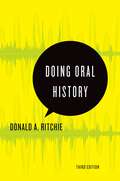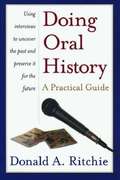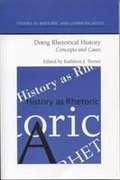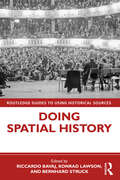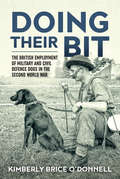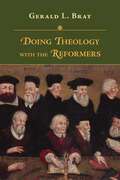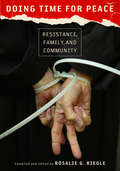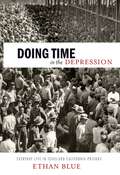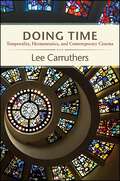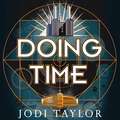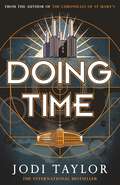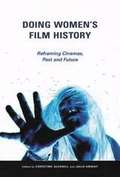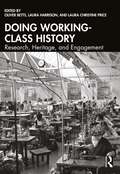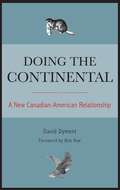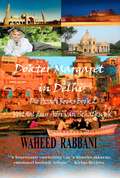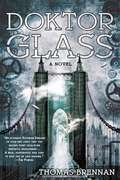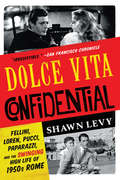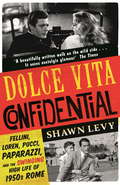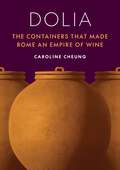- Table View
- List View
Doing Oral History
by Donald A. RitchieDoing Oral History is considered the premier guidebook to oral history, used by professional oral historians, public historians, archivists, and genealogists as a core text in college courses and throughout the public history community. Over the past decades, the development of digital audio and video recording technology has continued to alter the practice of oral history, making it even easier to produce quality recordings and to disseminate them on the Internet. This basic manual offers detailed advice on setting up an oral history project, conducting interviews, making video recordings, preserving oral history collections in archives and libraries, and teaching and presenting oral history. Using the existing Q&A format, the third edition asks new questions and augments previous answers with new material, particularly in these areas: 1. Technology: As before, the book avoids recommending specific equipment, but weighs the merits of the types of technology available for audio and video recording, transcription, preservation, and dissemination. Information about web sites is expanded, and more discussion is provided about how other oral history projects have posted their interviews online. 2. Teaching: The new edition addresses the use of oral history in online teaching. It also expands the discussion of Institutional Review Boards (IRBs) with the latest information about compliance issues. 3. Presentation: Once interviews have been conducted, there are many opportunities for creative presentation. There is much new material available on innovative forms of presentation developed over the last decade, including interpretive dance and other public performances. 4. Legal considerations: The recent Boston College case, in which the courts have ruled that Irish police should have access to sealed oral history transcripts, has re-focused attention on the problems of protecting donor restrictions. The new edition offers case studies from the past decade. 5. Theory and Memory: As a beginner's manual, Doing Oral History has not dealt extensively with theoretical issues, on the grounds that these emerge best from practice. But the third edition includes the latest thinking about memory and provides a sample of some of the theoretical issues surrounding oral sources. It will include examples of increased studies into catastrophe and trauma, and the special considerations these have generated for interviewers. 6. Internationalism: Perhaps the biggest development in the past decade has been the spreading of oral history around the world, facilitated in part by the International Oral History Association. New oral history projects have developed in areas that have undergone social and political upheavals, where the traditional archives reflect the old regimes, particularly in Eastern Europe, the Middle East, Asia, Africa, and Latin America. The third edition includes many more references to non-U.S. projects that will still be relevant to an American audience. These changes make the third edition of Doing Oral History an even more useful tool for beginners, teachers, archivists, and all those oral history managers who have inherited older collections that must be converted to the latest technology.
Doing Oral History: A Practical Guide
by Donald A. RitchieOral history is vital to our understanding of the cultures and experiences of the past. Unlike written history, oral history forever captures people's feelings, expressions, and nuances of language. But what exactly is oral history? How reliable is the information gathered by oral history? And what does it take to become an oral historian? Donald A. Ritchie, a leading expert in the field, answers these questions and in particular, explains the principles and guidelines created by the Oral History Association to ensure the professional standards of oral historians. <P><P> Doing Oral History has become one of the premier resources in oral history. It explores all aspects of the field, from starting an oral history project, including funding, staffing, and equipment to conducting interviews; publishing; videotaping; preserving materials; teaching oral history; and using oral history in museums and on the radio. In this second edition, the author has incorporated new trends and scholarship, updated and expanded the bibliography and appendices, and added a new focus on digital technology and the Internet. Appendices include sample legal release forms and information on oral history organizations. <P><P> Doing Oral History is a definitive step-by-step guide that provides advice and explanations on how to create recordings that illuminate human experience for generations to come. Illustrated with examples from a wide range of fascinating projects, this authoritative guide offers clear, practical, and detailed advice for students, teachers, researchers, and amateur genealogists who wish to record the history of their own families and communities.
Doing Public Humanities
by Susan SmulyanDoing Public Humanities explores the cultural landscape from disruptive events to websites, from tours to exhibits, from after school arts programs to archives, giving readers a wide-ranging look at the interdisciplinary practice of public humanities. Combining a practitioner’s focus on case studies with the scholar’s more abstract and theoretical approach, this collection of essays is useful for both teaching and appreciating public humanities. The contributors are committed to presenting a public humanities practice that encourages social justice and explores the intersectionalities of race, class, gender, and sexualities. Centering on the experiences of students with many of the case studies focused on course projects, the content will enable them to relate to and better understand this new field of study. The text is essential reading for undergraduate and graduate classes in public history, historic preservation, history of art, engaged sociology, and public archaeology and anthropology, as well as public humanities.
Doing Rhetorical History: Concepts and Cases
by Kathleen J. TurnerThis collection argues that rhetorical history, both as a methodology and as a perspective, offers insights that are central to the study of communication and unavailable through other approaches. The conceptualizations and methodologies of rhetorical history will increase in significance during the burgeoning "Communication Age" as we seek to cope with the present and prepare for the future by better understanding the past. This volume serves as an overview of a recently neglected methodological approach and acts as the first step in ending that neglect.
Doing Spatial History (Routledge Guides to Using Historical Sources)
by Bernhard Struck Riccardo Bavaj Konrad LawsonThis volume provides a practical introduction to spatial history through the lens of the different primary sources that historians use. It is informed by a range of analytical perspectives and conveys a sense of the various facets of spatial history in a tangible, case-study based manner. The chapter authors hail from a variety of fields, including early modern and modern history, architectural history, historical anthropology, economic and social history, as well as historical and human geography, highlighting the way in which spatial history provides a common forum that facilitates discussion across disciplines. The geographical scope of the volume takes readers on a journey through central, western, and east central Europe, to Russia, the Mediterranean, the Ottoman Empire, and East Asia, as well as North and South America, and New Zealand. Divided into three parts, the book covers particular types of sources, different kinds of space, and specific concepts, tools and approaches, offering the reader a thorough understanding of how sources can be used within spatial history specifically but also the different ways of looking at history more broadly. Very much focusing on doing spatial history, this is an accessible guide for both undergraduate and postgraduate students within modern history and its related fields.
Doing Their Bit: The British Employment of Military and Civil Defence Dogs in the Second World War
by Kimberly Brice O'DonnellThe Second World War allowed for the utilization of an unprecedented number of dogs for military duties both internationally and among the British Armed Forces. On the British Home Front, civilians responded to calls from the British Army’s War Dogs Training School and the Ministry of Aircraft Production Guard Dog Training School by donating their canine pets for military training and employment “for the duration.” As dogs were instructed in roles with the British Army, the Royal Air Force and the London Civil Defence Region, the distinction between pet and trained working animal became increasingly unclear. While civilians and servicemen alike continued to view military dogs as pets, many also saw trained canines as human-like soldiers “doing their bit,” a depiction promulgated by both the military and the wartime press. Despite the contributions of military and Civil Defence dogs, historians have paid little attention to their employment by the British Armed Forces and on the British Home Front in the First and Second World Wars. In the first comprehensive scholarly account of the employment of British military and Civil Defence dogs in the Second World War, Kimberly Brice O’Donnell traces the development of the British military dog scheme from the British Army’s belated establishment of the short-lived War Dog School and the Messenger Dog Service of the First World War to the more recent employment of canines during the wars in Iraq and Afghanistan in the early twenty-first century. With a focus on the Second World War, Doing their Bit examines why and how dogs were trained and employed by the British Armed Forces and the London Civil Defence Region and how humans shaped and perceived their use. Utilizing a range of archival material, O’Donnell analyses the performance of guard, military police, patrol, mine detection and rescue dogs in training and on operations by considering the advantages and disadvantages of utilizing canines in such roles. Military and Civil Defence dogs offered a number of advantages over the employment of humans and technological equipment, and the experience gained by dog trainers and handlers during the Second World War led to the continued employment of canines in the postwar period. While the use of horses and other animals has since diminished, the Second World War marked a turning point in the history of the British military dog, ushering in the seemingly permanent training of dogs for police and military roles.
Doing Theology with the Reformers
by Gerald L. BrayThe Reformation was a time of tremendous upheaval, renewal, and vitality in the life of the church. The challenge to maintain and develop faithful Christian belief and practice in the midst of great disruption was reflected in the theology of the sixteenth century. In this volume, which serves as a companion to IVP Academic's Reformation Commentary on Scripture, theologian and church historian Gerald L. Bray immerses readers in the world of Reformation theology. He introduces the range of theological debates as Catholics and Protestants from a diversity of traditions—Lutheran, Reformed, Anglican, and Anabaptist—disputed the essentials of the faith, from the authority of Scripture and the nature of salvation to the definition of the church, the efficacy of the sacraments, and the place of good works in the Christian life. Readers will find that understanding how the Reformers engaged in the theological discipline can aid us in doing theology today.
Doing Time for Peace: Resistance, Family, and Community
by Rosalie G. Riegle Dan McKananIn this compelling collection of oral histories, more than seventy-five peacemakers describe how they say no to war-making in the strongest way possible--by engaging in civil disobedience and paying the consequences in jail or prison. These courageous resisters leave family and community and life on the outside in their efforts to direct U.S. policy away from its militarism. Many are Catholic Workers, devoting their lives to the works of mercy instead of the works of war. They are homemakers and carpenters and social workers and teachers who are often called "faith-based activists." They speak from the left of the political perspective, providing a counterpoint to the faith-based activism of the fundamentalist Right.In their own words, the narrators describe their motivations and their preparations for acts of resistance, the actions themselves, and their trials and subsequent jail time. We hear from those who do their time by caring for their families and managing communities while their partners are imprisoned. Spouses and children talk frankly of the strains on family ties that a life of working for peace in the world can cause. The voices range from a World War II conscientious objector to those protesting the recent war in Iraq. The book includes sections on resister families, the Berrigans and Jonah House, the Plowshares Communities, the Syracuse Peace Council, and Catholic Worker houses and communities.The introduction by Dan McKanan situates these activists in the long tradition of resistance to war and witness to peace.
Doing Time for Peace: Resistance, Family, and Community
by Rosalie G. RiegleIn this compelling collection of oral histories, more than seventy-five peacemakers describe how they say no to war-making in the strongest way possible--by engaging in civil disobedience and paying the consequences in jail or prison. These courageous resisters leave family and community and life on the outside in their efforts to direct U.S. policy away from its militarism. Many are Catholic Workers, devoting their lives to the works of mercy instead of the works of war. They are homemakers and carpenters and social workers and teachers who are often called "faith-based activists." They speak from the left of the political perspective, providing a counterpoint to the faith-based activism of the fundamentalist Right. In their own words, the narrators describe their motivations and their preparations for acts of resistance, the actions themselves, and their trials and subsequent jail time. We hear from those who do their time by caring for their families and managing communities while their partners are imprisoned. Spouses and children talk frankly of the strains on family ties that a life of working for peace in the world can cause. The voices range from a World War II conscientious objector to those protesting the recent war in Iraq. The book includes sections on resister families, the Berrigans and Jonah House, the Plowshares Communities, the Syracuse Peace Council, and Catholic Worker houses and communities. The introduction by Dan McKanan situates these activists in the long tradition of resistance to war and witness to peace.
Doing Time in the Depression: Everyday Life in Texas and California Prisons (American History and Culture #7)
by Ethan BlueAs banks crashed, belts tightened, and cupboards emptied across the country, American prisons grew fat. Doing Time in the Depression tells the story of the 1930s as seen from the cell blocks and cotton fields of Texas and California prisons, state institutions that held growing numbers of working people from around the country and the world—overwhelmingly poor, disproportionately non-white, and displaced by economic crisis.Ethan Blue paints a vivid portrait of everyday life inside Texas and California’s penal systems. Each element of prison life—from numbing boredom to hard labor, from meager pleasure in popular culture to crushing pain from illness or violence—demonstrated a contest between keepers and the kept. From the moment they arrived to the day they would leave, inmates struggled over the meanings of race and manhood, power and poverty, and of the state itself. In this richly layered account, Blue compellingly argues that punishment in California and Texas played a critical role in producing a distinctive set of class, race, and gender identities in the 1930s, some of which reinforced the social hierarchies and ideologies of New Deal America, and others of which undercut and troubled the established social order. He reveals the underside of the modern state in two very different prison systems, and the making of grim institutions whose power would only grow across the century.
Doing Time: A Look at Crime and Prisons
by Phyllis Elperin Clark Robert LehrmanA criticism of today's prisons with suggestions on how to improve the criminal justice situation<P><P> Jane Addams Children’s Book Award Honor Book
Doing Time: Temporality, Hermeneutics, and Contemporary Cinema (SUNY series, Horizons of Cinema)
by Lee CarruthersDoing Time addresses two areas of interest in recent film study—film temporality and film philosophy—to propose an innovative theorization of cinematic time that sees it as a dynamic process of engagement, or something we do as viewers. This active relation to cinematic time, which discloses a film's temporal character, is called its "timeliness." Here it is traced across a range of fascinating case studies from Hollywood and the global art cinema, uncovering each film's characteristic way of "doing time." Throughout, the ambiguities of filmic time are held as powerful attractions as they modulate film viewing: such pauses, gaps, repetitions, and stretches of time illuminate a living field that extends from viewing activity.Drawing on the writings of French film critic and theorist André Bazin, as well as the phenomenology of Martin Heidegger and Maurice Merleau-Ponty, Lee Carruthers forwards a claim about the value of cinematic time for thinking. She also raises the tasks of film analysis and interpretation to renewed visibility. By prioritizing the viewer's experience of filmic temporality, and offering a rich vocabulary for describing this exchange, Carruthers articulates a new sphere of theoretical inquiry that invites film viewers (and readers) to participate.
Doing Time: The Time Police, Book 1 (The Time Police #1)
by Jodi TaylorIntroducing The Time Police, the brand-new series by international bestselling author, Jodi Taylor - an irresistible spinoff from the much-loved Chronicles of St Mary's series. Perfect reading for fans of Doctor Who, Terry Pratchett and Jasper Fforde. 'The best way to describe this book: lots of fun' British Fantasy Society'Inventive and entertaining... a fast-paced and fun first book in what promises to be an excellent new series' CultureflyA long time ago in the future, the secret of time travel became known to all. Unsurprisingly, the world nearly ended. There will always be idiots who want to change history.Enter the Time Police. An all-powerful, international organisation tasked with keeping the timeline straight. At all costs. Their success is legendary. The Time Wars are over. But now they must fight to save a very different future - their own. This is the story of Jane, Luke and Matthew - the worst recruits in Time Police history. Or, very possibly, three young people who might change everything. DOING TIME is a five-star read!:'I blooming well loved this book. Read start to finish in only a couple of sittings' *****'Excellent start to this St Mary's Chronicles spinoff series. There is Taylor's trademark humour, along with moments of real lump-in-the-throat poignancy' *****'Clever, witty, humourous, touching, emotional, just about everything anyone could want. Can't wait for the next one' *****'Another superb book from the pen of Jodi Taylor' *****'This book does not disappoint' *****
Doing Time: a hilarious new spinoff from the Chronicles of St Mary's series (The Time Police #1)
by Jodi TaylorIntroducing The Time Police, the brand-new series by international bestselling author, Jodi Taylor - an irresistible spinoff from the much-loved Chronicles of St Mary's series. Perfect reading for fans of Doctor Who, Terry Pratchett and Jasper Fforde. 'The best way to describe this book: lots of fun' British Fantasy Society'Inventive and entertaining... a fast-paced and fun first book in what promises to be an excellent new series' CultureflyA long time ago in the future, the secret of time travel became known to all. Unsurprisingly, the world nearly ended. There will always be idiots who want to change history.Enter the Time Police. An all-powerful, international organisation tasked with keeping the timeline straight. At all costs. Their success is legendary. The Time Wars are over. But now they must fight to save a very different future - their own. This is the story of Jane, Luke and Matthew - the worst recruits in Time Police history. Or, very possibly, three young people who might change everything. DOING TIME is a five-star read!:'I blooming well loved this book. Read start to finish in only a couple of sittings' *****'Excellent start to this St Mary's Chronicles spinoff series. There is Taylor's trademark humour, along with moments of real lump-in-the-throat poignancy' *****'Clever, witty, humourous, touching, emotional, just about everything anyone could want. Can't wait for the next one' *****'Another superb book from the pen of Jodi Taylor' *****'This book does not disappoint' *****
Doing Time: a hilarious new spinoff from the Chronicles of St Mary's series (The\time Police Ser. #1)
by Jodi TaylorIntroducing The Time Police, the brand-new series by international bestselling author, Jodi Taylor - an irresistible spinoff from the much-loved Chronicles of St Mary's series. Perfect reading for fans of Doctor Who, Terry Pratchett and Jasper Fforde. 'The best way to describe this book: lots of fun' British Fantasy Society'Inventive and entertaining... a fast-paced and fun first book in what promises to be an excellent new series' CultureflyA long time ago in the future, the secret of time travel became known to all. Unsurprisingly, the world nearly ended. There will always be idiots who want to change history.Enter the Time Police. An all-powerful, international organisation tasked with keeping the timeline straight. At all costs. Their success is legendary. The Time Wars are over. But now they must fight to save a very different future - their own. This is the story of Jane, Luke and Matthew - the worst recruits in Time Police history. Or, very possibly, three young people who might change everything. DOING TIME is a five-star read!:'I blooming well loved this book. Read start to finish in only a couple of sittings' *****'Excellent start to this St Mary's Chronicles spinoff series. There is Taylor's trademark humour, along with moments of real lump-in-the-throat poignancy' *****'Clever, witty, humourous, touching, emotional, just about everything anyone could want. Can't wait for the next one' *****'Another superb book from the pen of Jodi Taylor' *****'This book does not disappoint' *****
Doing Women's Film History: Reframing Cinemas, Past and Future
by Julia Knight Jane Gaines Christine Gledhill Monica Dall'AstaResearch into and around women's participation in cinematic history has enjoyed dynamic growth over the past decade. A broadening of scope and interests encompasses not only different kinds of filmmaking--mainstream fiction, experimental, and documentary--but also practices--publicity, journalism, distribution and exhibition--seldom explored in the past. Cutting-edge and inclusive, Doing Women's Film History ventures into topics in the United States and Europe while also moving beyond to explore the influence of women on the cinemas of India, Chile, Turkey, Russia, and Australia. Contributors grapple with historiographic questions that cover film history from the pioneering era to the present day. Yet the writers also address the very mission of practicing scholarship. Essays explore essential issues like identifying women's participation in their cinema cultures, locating previously unconsidered sources of evidence, developing methodologies and analytical concepts to reveal the impact of gender on film production, distribution and reception, and reframing film history to accommodate new questions and approaches. Contributors include: Kay Armatage, Eylem Atakav, Karina Aveyard, Canan Balan, Cécile Chich, Monica Dall'Asta, Eliza Anna Delveroudi, Jane M. Gaines, Christine Gledhill, Julia Knight, Neepa Majumdar, Michele Leigh, Luke McKernan, Debashree Mukherjee, Giuliana Muscio, Katarzyna Paszkiewicz, Rashmi Sawhney, Elizabeth Ramirez Soto, Sarah Street, and Kimberly Tomadjoglou.
Doing Working-Class History: Research, Heritage, and Engagement
by Laura Harrison Oliver Betts Laura Christine PriceEconomic and political uncertainty has brought the language of class – especially discussion of the working class – to a broad audience across scholarship and social debate. This introductory volume shows how the history of the working class has, is, and can be researched, written, and represented.The book is structured in three parts: perspective, context, and application. Each offers an introduction to both classic historiography and new ideas and methodologies. With chapters covering a span of the years c.1750–present, the book focuses on three essential questions: What is working-class history and what should it become? What can a focus on working-class history reveal? What are the possibilities of this research in the university classroom, the heritage world, and beyond? Doing Working-Class History will appeal to students and scholars of working-class history, whether relative newcomers to the field or veteran researchers interested in new approaches and material. It will also be of interest to local and family historians, museum and heritage professionals, and general readers.
Doing the Continental: A New Canadian-American Relationship
by Bob Rae David DymentAdvance Praise for Doing the Continental: "Everyone has opinions about the state of Canada-U.S. relations, but few have the knowledge to provide informed judgments. Professor Dyment happily falls into the latter category. While some of the prescriptions are controversial, this concise book has been carefully thought out and provides excellent grist for the Canadian policy mill. Doing the Continental is a must read for those interested in Canadian-American relations." Michael Kergin, Canada’s Ambassador to the United States, 2000 to 2005. When President Barack Obama sat at his desk for the first time in the Oval Office in January 2009, one of the farthest things from his mind was Canada. On Capitol Hill the whirling pursuit of interests was intense. In Ottawa, Canada’s senior officials were too preoccupied to appreciate that the nations neighbours to the south weren’t paying attention to the affairs and concerns of the Great White North. Canada’s relations with the United States are broad and deep, and with Obama in his second term in office, the two countries have entered what could be considered a new era of hope and renewal. From water and energy policy to defence, environmental strategy, and Arctic sovereignty, David Dyment provides an astute, pithy analysis of the past, present, and future continental dance between two countries that have much in common, yet often step on each others feet.
Dokter Margaret in Delhi
by Waheed Rabbani Adri Van SchalkwykDokter Margaret reis alleen na Indië om by haar ouers by die Amerikaanse Presbiteriaanse Sendingstasie in Futtehgurh te wees en dan na haar pos by ‘n hospitaal in Delhi. Daar moet sy nie net werkdruk oorkom nie, maar ook met haar intimideerders en intriges van die Mughals, by die Delhi Rooi Fort deel. Margaret se martelaar sedert haar kinderjare, Kaptein Albert, sluit ook aan by ‘n Britse regiment wat vir diens in Indië gebasseer is. Die Rus, Kaptein Graaf Nicholai, wie Margaret in die Krim ontmoet het, arriveer ook in Indië onder die dekmantel van ‘n Franse dokter. Die gebeure wat tot die Indiese Muitery/Rebellie gelei het en uitgebreek het in 1857, het nie net ‘n baie groot invloed op Margaret se lewe nie, maar ook op diegene wat haar liefhet en ander wat haar skade wil berokken. Ook deurmekaar in die warboel is een van die Koning van Delhi, Shah Zafar se Rooi Fort Wagte, sepoy Sharif Khan Bhadur, die oupa van Dokter Wallidad, ‘n Amerikaanse dokter. Die Azadi Reeks dek die opwindende gebeure en onrus wat Indië deurvleg het van 1857 tot 1947 en tot haar onafhanklikheid gelei het. Daardie voorvalle verswelg die karakters van hierdie storie op daardie tydstip en later hul afstammelinge se lewens weer in die 1960’s.
Dokter Margaret se Seekis
by Waheed Rabbani Adri Van SchalkwykDokter Margaret se seekis, is Boek I van ʼn trilogie van historiese fiksie wat afspeel gedurende die stryd van Indië vir vryheid—Azadi—van die Britse Raj. Die boeke weef ʼn verhaal van internasionale intrige, konflik, en aangrypende liefde tussen interessante karakters van daardie era. In 1965 is ʼn seekis van meer as 100 jaar oud, vermoedelik dié van ʼn Amerikaanse dokter, Margaret, ontdek in die stoorkamer van ʼn hospitaal in Delhi. ʼn Ander Amerikaanse dokter, Sharif, wat oorspronklik afkomstig is uit Delhi en op kontrak is by die hospitaal, is toevertrou met die taak om die geheimsinnige vrou se familie op te spoor en die kis aan hul terug te besorg. Sharif spoor Margaret se nageslag in Grimsby, Ontario, Kanada op. Haar dagboeke en ander artefakte, soos die kroon van die Koninkryk van Jhansi, is in die kis gevind. Margaret, gebore in New Jersey uit ʼn Skotse Presbiteriaanse klerklike familie, oorwin geweldige struikelblokke en bereik haar hartsbegeerte in 1850 om een van die eerste Noord-Amerikaanse vroue dokters te word. Sy trou met haar Kanadese neef, Robert, en reis saam met hom om in die Krimoorlog van 1854 te dien. In die Krim kry hul nie net swaar met al die veldslae nie, maar moet ook ander konflikte verduur. Van gebeure wat gelei het tot en na die berugte Charge of the Light Brigade, ontmoet Margaret ʼn Russiese offisier, graaf Nicholai. Die verrassende einde van Boek I laat Margaret in ʼn verknorsing, moet sy wraak neem of moet sy voortgaan met haar reis na Indië. Op die ou end glo sy, sy het die regte besluit gemaak. ******************************************** ******************************************** “[Waheed] se weergawe van die Indiese Rebellie uit ʼn Indiese oogpunt is fassinerend vir die Westerse leser en behoort goed ontvang te word ...” – Ian Walker, skrywer van LOCA
Doktor Glass
by Thomas BrennanIn an age of Zeppelins and gyroplanes, atomics and horseless carriages, the Transatlantic Span is the industrial marvel of the nineteenth century. A monumental feat of engineering, the steel suspension bridge stretches across the Atlantic from Liverpool to the distant harbor of New York City, supported by no less than seven hundred towers. But in the shadows of its massive struts, on the docks of the River Mersey, lies a faceless corpse... Inspector Matthew Langton is still seized with grief when he thinks of Sarah, his late wife. Tortured by nightmares and afflicted by breathless attacks of despair and terror, he forces himself to focus on the investigation of the faceless man. The victim wears the uniform of the Transatlantic Span Company but bears the tattoos of the Boers--could there be a Boer conspiracy to assassinate Queen Victoria on the upcoming Inauguration Day of the Span? But the truth, as it begins to emerge, is far more bizarre than a political coup. As additional victims turn up--each with strange, twin burn marks on their necks--Langton draws a connection between the dead man beneath the bridge and chilling rumors of the Jar Bars, soul snatchers who come under cover of night. Most frightening of all is the mythic and elusive Doktor Glass, who may not only be behind the illicit trade in souls...but who may hold the key to what happened to the inspector's own beloved wife on her deathbed...
Doku
by Tam MacneilJao is the new Kazematsuri, the head of the Good Men assassins, though not many people know it yet. With the Empress Iyuko visiting Okatsu, things are hectic at the Hiroti household. Masahiro wants very much to bring his Kikuta-ware pottery to her notice, but how to do it? Throw a party, of course! He is delighted when the Empress's confidant, Higake no Doshu, arrives and asks Jao for a game of Shogi. It's all very civilized.But, wherever the Empress goes, plots and scheming follow.When Jao and Masahiro are deftly poisoned at their own party, Jao is blackmailed into helping a would-be assassin, bent on killing a member of the Empress's retinue and pinning the blame on the Daimyo.Jao hates politics, but he knows about poisons, and killing. And when Jao crumbles under the onslaught of the poison, it is Masahiro who takes matters into his own elegant hands.
Dolce Vita Confidential
by Shawn LevyFrom the ashes of World War II, Rome was reborn as the epicenter of film, fashion, creative energy, tabloid media, and bold-faced libertinism that made "Italian" a global synonym for taste, style, and flair. A confluence of cultural contributions created a bright, burning moment in history: it was the heyday of fashion icons such as Pucci, whose use of color, line, and superb craftsmanship set the standard for women's clothing for decades, and Brioni, whose confident and classy creations for men inspired the contemporary American suit. Rome's huge movie studio, Cinecitta, also known as "Hollywood-on-the Tiber," attracted a dizzying array of stars from Charleton Heston, Gregory Peck, Audrey Hepburn, Ava Gardner, and Frank Sinatra to that stunning and combustible couple, Elizabeth Taylor and Richard Burton, who began their extramarital affair during the making of Cleopatra. And behind these stars trailed street photographers--Tazio Secchiarioli, Pierluigi Praturlon, and Marcello Gepetti--who searched, waited, and pounced on their subjects in pursuit of the most unflattering and dramatic portraits of fame. Fashionistas, exiles, moguls, and martyrs flocked to Rome hoping for a chance to experience and indulge in the glow of old money, new stars, fast cars, wanton libidos, and brazen news photographers. The scene was captured nowhere better than in Federico Fellini's masterpiece, La Dolce Vita, starring Marcello Mastroianni and the Swedish bombshell Anita Ekberg. It was condemned for its licentiousness, when in fact Fellini was condemning the very excess, narcissism, and debauchery of Rome's bohemian scene. Gossipy, colorful, and richly informed, Dolce Vita Confidential re-creates Rome's stunning ascent with vivid and compelling tales of its glitterati and artists, down to every last outrageous detail of the city's magnificent transformation.
Dolce Vita Confidential: Fellini, Loren, Pucci, Paparazzi and the Swinging High Life of 1950s Rome
by Shawn LevySUNDAY TIMES FILM BOOK OF THE YEAR 'Uproariously readable ... Levy is a master of the group biography' Sunday Times'Teeming with satisfying gossipy details' Guardian'Exalts the intoxicating, beguiling dreaminess of Rome in its celluloid heyday' TLS 1950s Rome. From the ashes of war, the Eternal City is reborn as the epicentre of film, style and boldfaced libertinism. Movie stars including Ingrid Bergman, Audrey Hepburn and Elizabeth Taylor flock to Cinecittà studio and mix with blue bloods and bohemians at the bars on Via Veneto, while behind them trail street photographers in pursuit of the most unflattering and dramatic portraits of fame. In a fast-paced, kaleidoscopic narrative, Shawn Levy recreates Rome's ascent with compelling tales of its glitterati and artists, down to every last outrageous detail of the city's magnificent transformation into 'Hollywood on the Tiber'.
Dolia: The Containers That Made Rome an Empire of Wine
by Caroline CheungThe story of the Roman Empire’s enormous wine industry told through the remarkable ceramic storage and shipping containers that made it possibleThe average resident of ancient Rome drank two-hundred-and-fifty liters of wine a year, almost a bottle a day, and the total annual volume of wine consumed in the imperial capital would have overflowed the Pantheon. But Rome was too densely developed and populated to produce its own food, let alone wine. How were the Romans able to get so much wine? The key was the dolium—the ancient world’s largest type of ceramic wine and food storage and shipping container, some of which could hold as much as two-thousand liters. In Dolia, classicist and archaeologist Caroline Cheung tells the story of these vessels—from their emergence and evolution to their major impact on trade and their eventual disappearance.Drawing on new archaeological discoveries and unpublished material, Dolia uncovers the industrial and technological developments, the wide variety of workers and skills, and the investments behind the Roman wine trade. As the trade expanded, potters developed new techniques to build large, standardized dolia for bulk fermentation, storage, and shipment. Dolia not only determined the quantity of wine produced but also influenced its quality, becoming the backbone of the trade. As dolia swept across the Mediterranean and brought wine from the far reaches of the empire to the capital’s doorstep, these vessels also drove economic growth—from rural vineyards and ceramic workshops to the wine shops of Rome.Placing these unique containers at the center of the story, Dolia is a groundbreaking account of the Roman Empire’s Mediterranean-wide wine industry.
